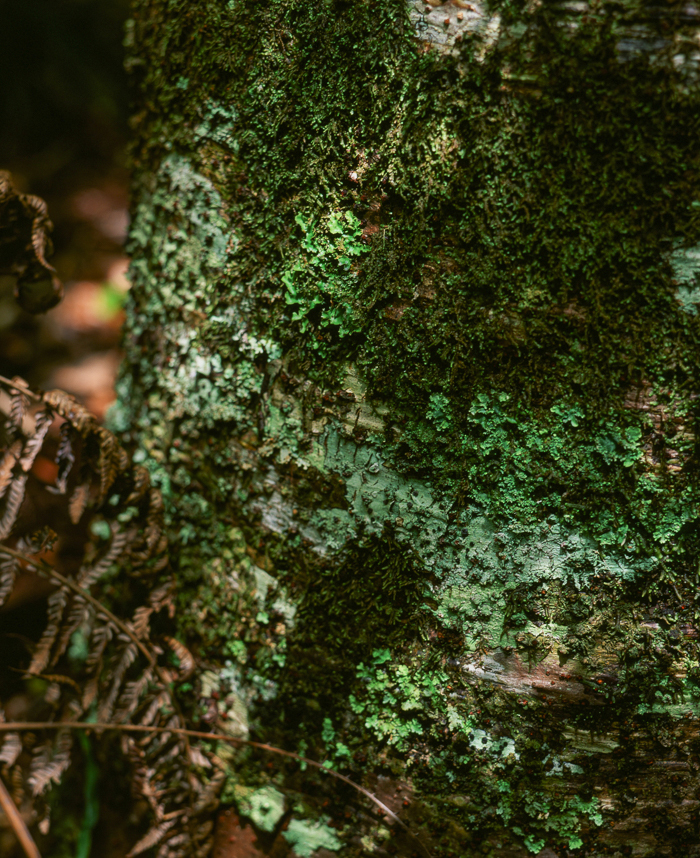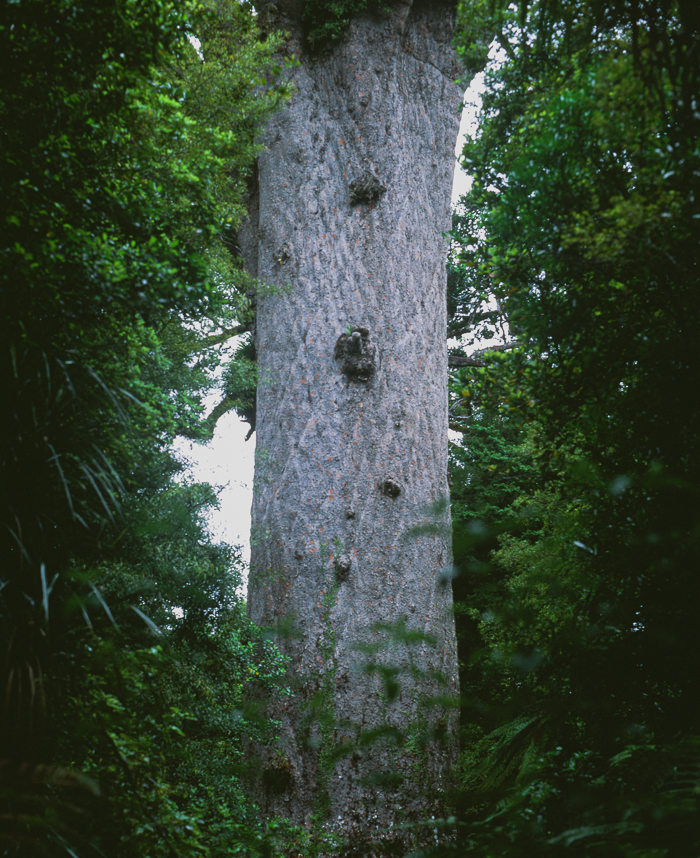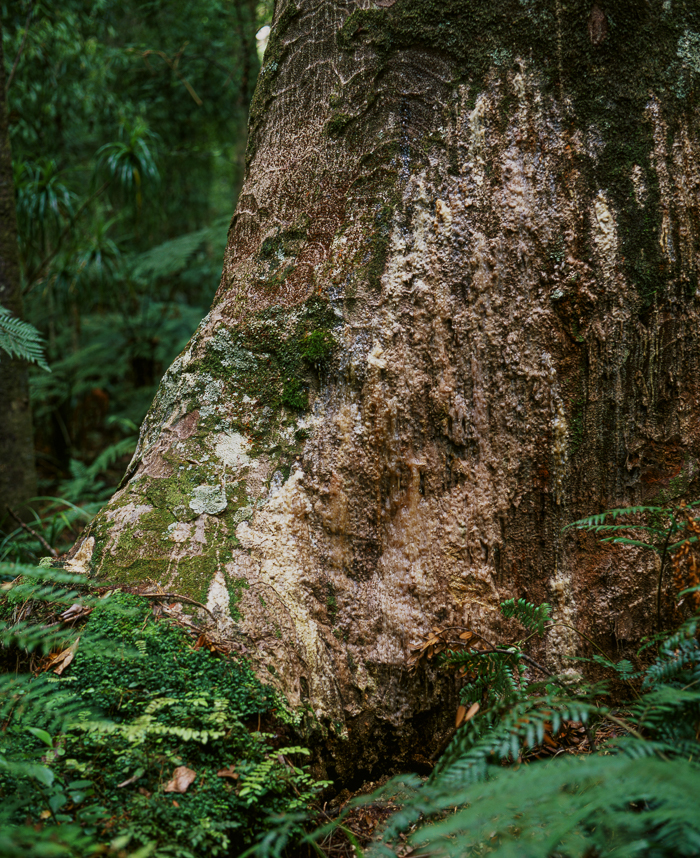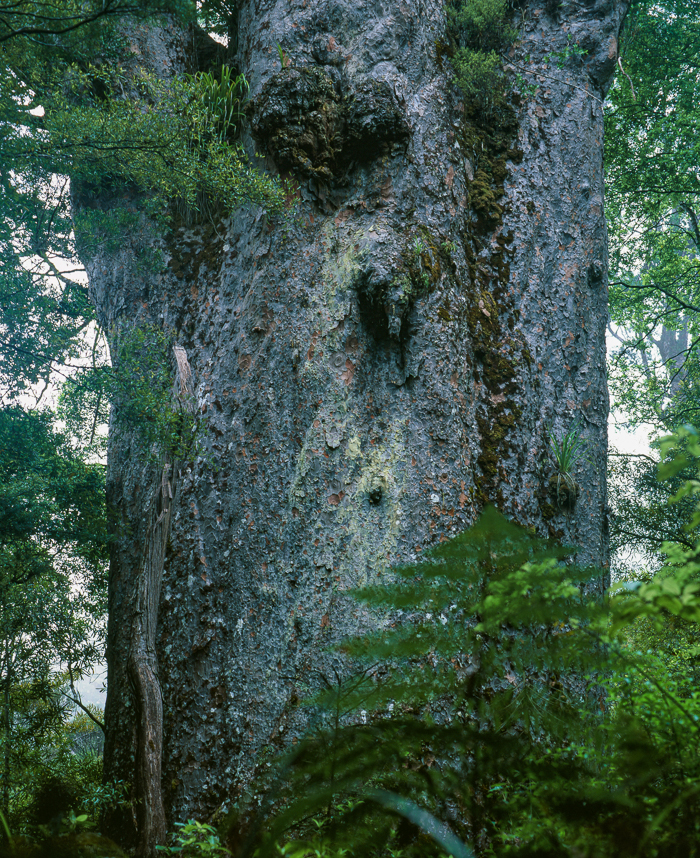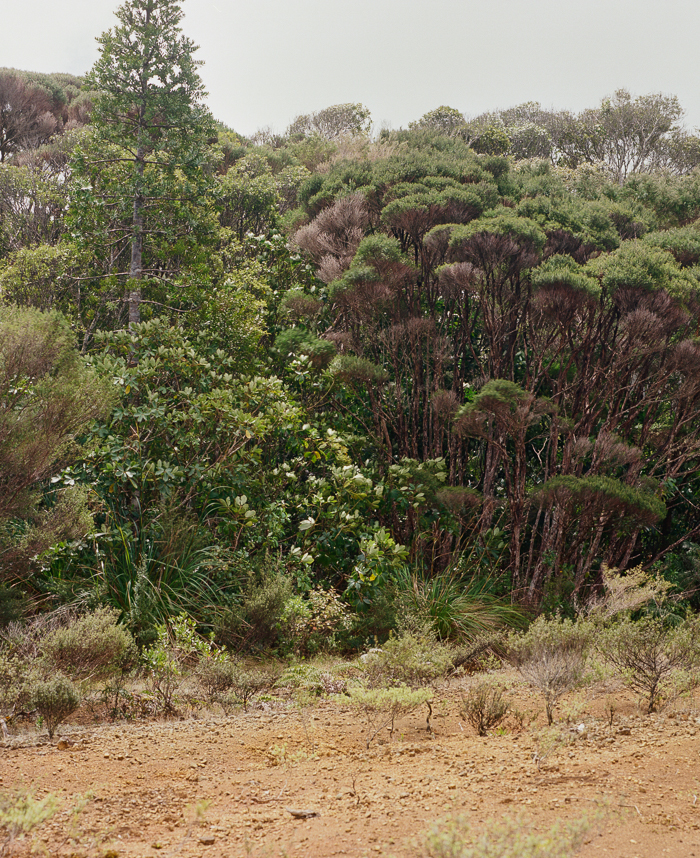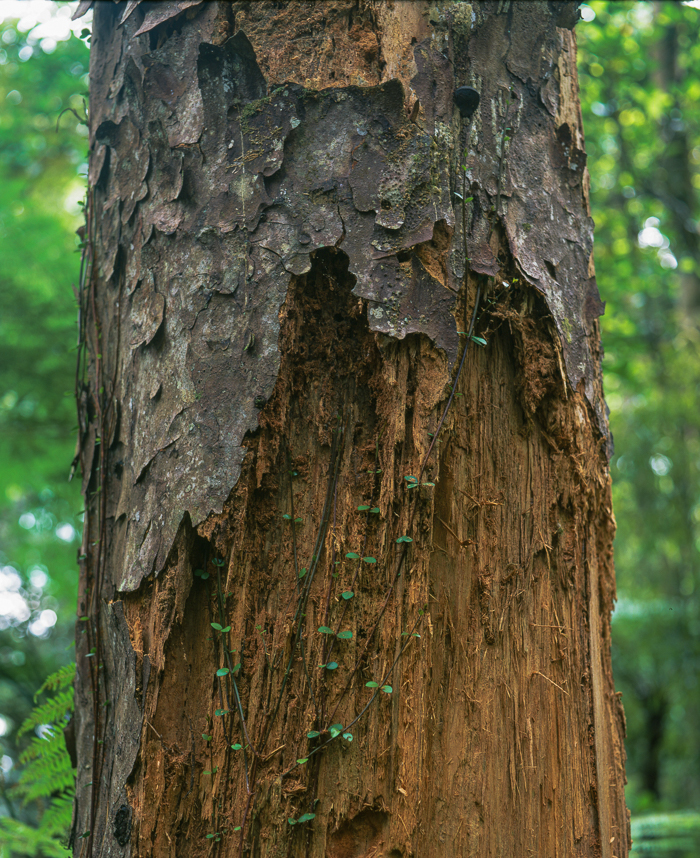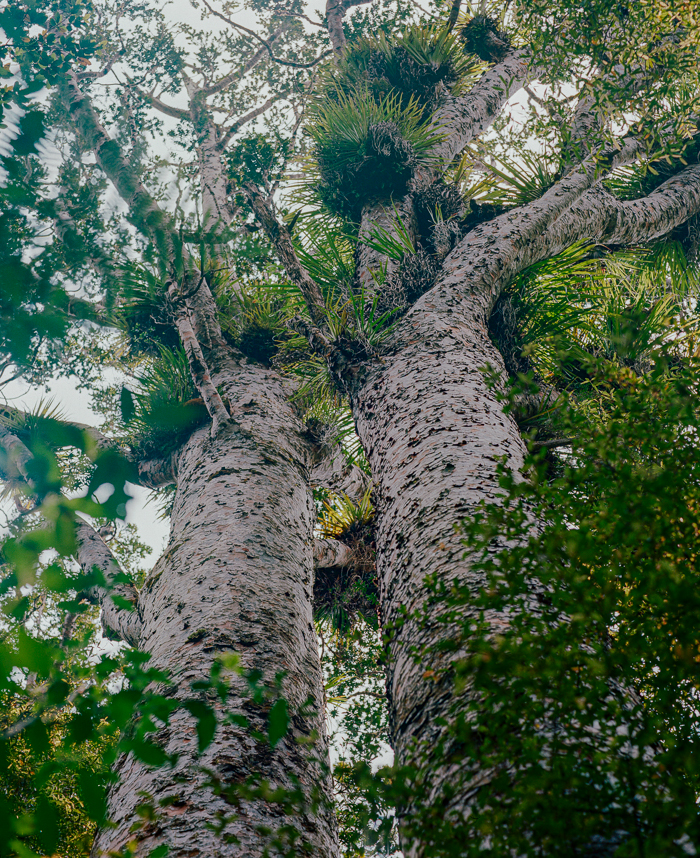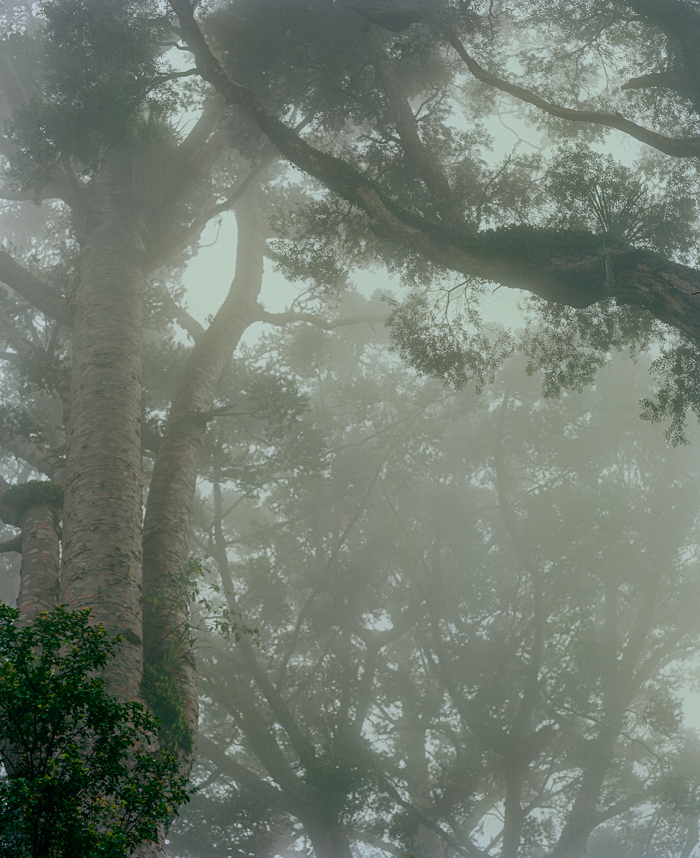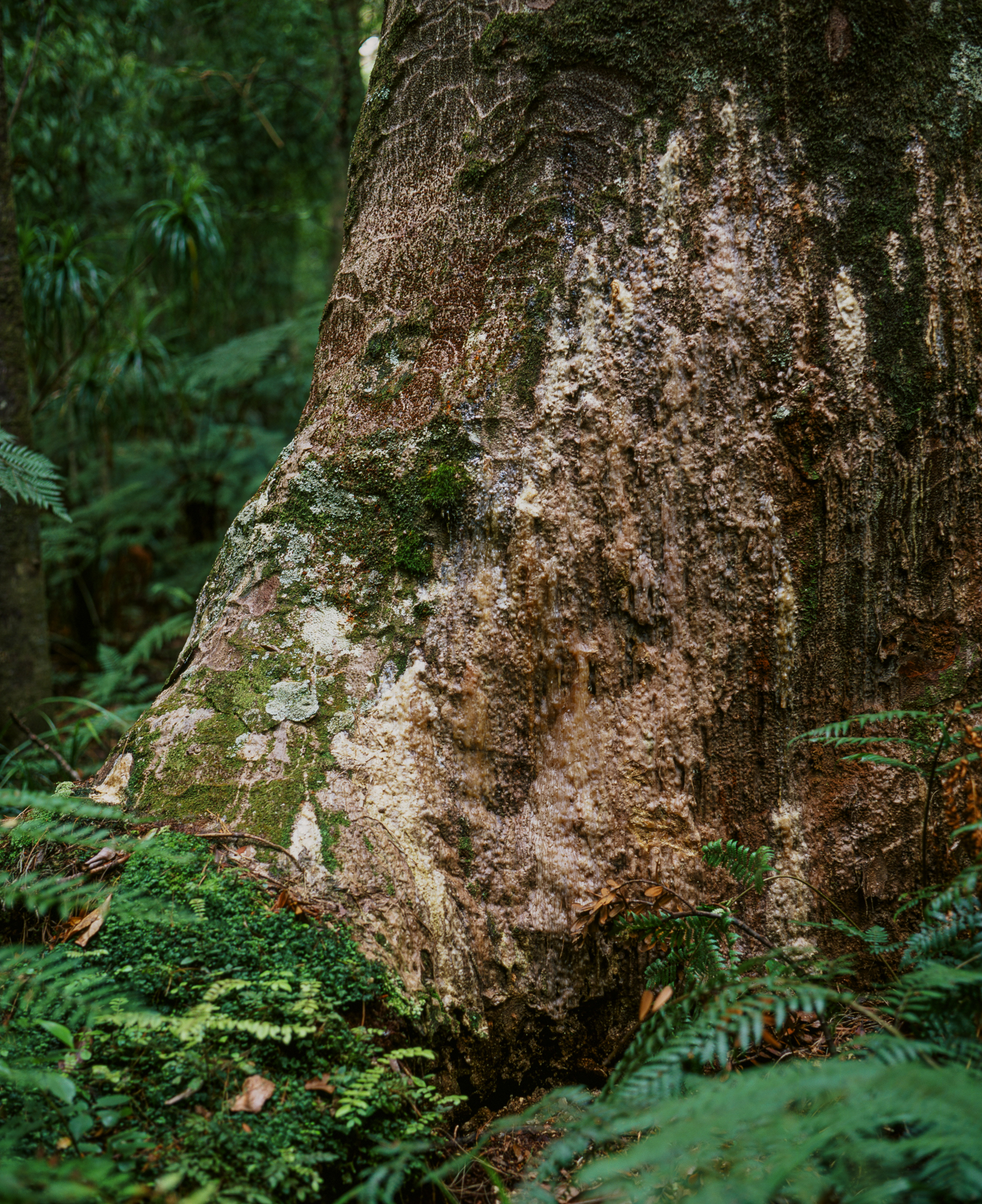
Kauri Dieback Disease
Part 1
Introduction of Pathogen
During the 21st century, kauri have experienced a brief respite from the deforestation wrought by the commercial exploitation of previous industries (more in chapter VI). There has been a combined effort by government agencies and private environmental trusts to rectify the sins of the past by supporting ecological restoration projects and funding educational programming and infrastructure to safeguard the remaining kauri forests. Te Uru Rākau (Forestry New Zealand) has developed the One Billion Trees program to double the current planting rate to reach one billion trees planted by 2028, not to be confused with the United States’ claim of planting one trillion trees under the leadership of the 45th President.68 Forestry New Zealand, “One Billion Trees Programme.” Equally important is the work being done by iwi who disseminate information about the significant role of kauri in Māori creation mythology and traditional cultural practice, and educate visitors about the importance of native biodiversity for forest health.
Regrettably, kauri cannot exist in the modern world without facing a threat, for in 2008 a pathogen was identified to cause kauri incurable and ultimately fatal damage. Properly named in 2015 as Phytophthora agathidicida (previously called Phytophthora 'taxon Agathis' or PTA), the microscopic soil-borne pathogen is commonly known as the disease it inflicts, kauri dieback.69
“Kauri Dieback - Phytophthora agathidicida: The Problem.”
To infect the kauri, the microscopic pathogen uses its tail-like flagella to enter the tree’s system through its roots. Once introduced, the oospores affect the tree’s ability to take up nutrients, causing the visible symptoms that give the disease its nickname Kauri Dieback Disease (KDB). An infected kauri shows symptoms of root rot, collar rot, bleeding resin around its trunk base, yellowing and chlorosis of its leaves followed by defoliation in its canopy until it ultimately succumbs to death. Like the standing corpses bled of gum in Manuel Dunn’s time, kauri infected with KDB perish erect and remain a symbol of strength amid a landscape of swelling uncertainty.

The pathogen easily transmits through soil carried from infected forests into healthy ones and – having spread for a while before it was identified – the pathogen is already well-established in most of New Zealand’s remaining kauri forests. Kauri Dieback is most prolific in Waipoua, Trounson Kauri Park, the Waitakere Ranges and on Great Barrier Island, but as it may live dormant for long periods in soil and is highly transmissible, the threat to kauri nationwide is imminent.70 “Kauri Dieback - Phytophthora agathidicida: The Problem.” The main vehicles for its transmission are the dirty boots of trampers and the extremities of roaming animals and pests like wild pigs, horses, cats, dogs, stoats and possums. Despite the pathogen’s straightforward transmission, the specific factors that make kauri more resistant or vulnerable to the disease are a bit more elusive. While the density of kauri in Northland compared to other regions in the country makes it the logical epicenter of disease prevention efforts, Kauri Dieback distribution across the North Island is perplexing. There are severe clusters of infection in areas like the Waitakere Ranges down by Auckland, minimal cases like the three confirmed infected trees on private land bordering Warawara, and other forested regions that remain enigmatically free from Kauri Dieback altogether. Even inside infected forests, like Waipoua, affected trees stand neighboring healthy ones, leaving no discernable criteria to predict the pathogen’s route or vulnerabilities (fig. 20).
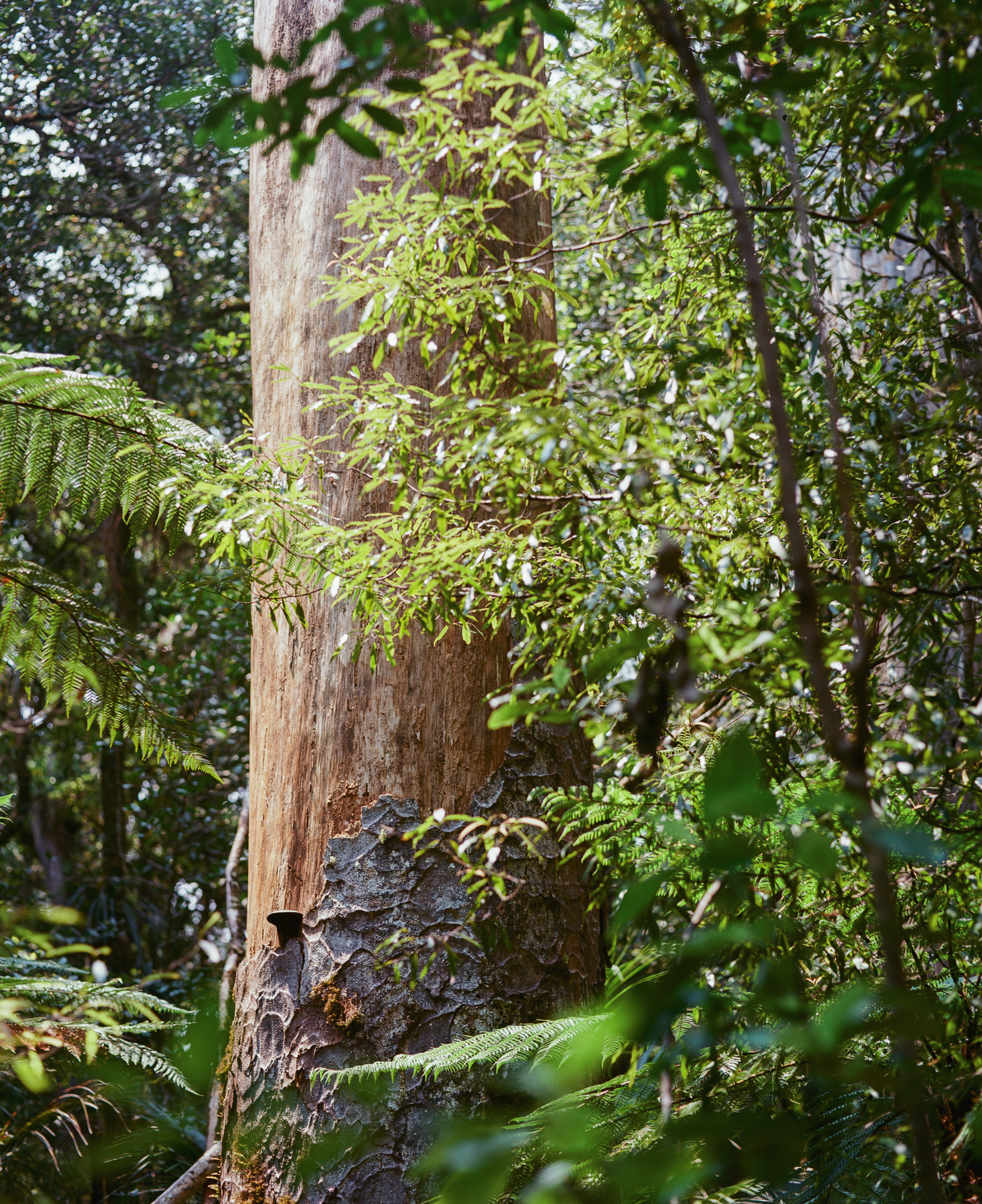
Prevention: Divergent Perspectives
Pākehā and Māori hold divergent perspectives on Kauri Dieback Disease. One spot of friction is where Western standards of scientific data clash with the indigenous perspective of observation-based action and mātauranga Māori. The government, with the Department of Conservation as its primary stewarding body, has favored the outlook and practices of the Western science community when it comes to environmental management. Given how unrelenting the pathogen is, many Māori stewards of at-risk forests have chosen to heed DOC advice and make decisions based on the latest science, even if it is out of step with their traditional ecological knowledge.
DOC has assumed a significant role in confronting Kauri Dieback, often working with private landowners and iwi to organize a multi-pronged approach to protect the ecological, economic and cultural wellbeing of indigenous flora and fauna. In order to mitigate the spread of Kauri Dieback, DOC and its partners developed a comprehensive infrastructural intervention plan for the public forest land of Northland in addition to funding and expanding an already operational Pest Management & Control program throughout the island. In most areas where DOC operates, especially those in which iwi have settled land disputes with the Crown and reclaimed ownership of their area, a system of co-management is practiced by iwi and DOC personnel. In theory, the system should ensure an effective, culturally sensitive approach to land care that consults relevant iwi, heeds mātauranga Māori perspectives, incorporates tikanga and wairuatanga protocols and provides a measure of the mauri of the ngahere.
Warawara & Waipoua
Two of Northland’s prominent native kauri forests, Warawara and Waipoua, illustrate different degrees of iwi and DOC collaboration to manage and safeguard the ngahere against the threat of Kauri Dieback Disease. Their circumstances differ in the specifics of which advisory bodies hold authority, but both approaches illuminate viable paths to protect the taonga species. Every forest, river and mountain is significant, but the relative proximity and historical ties connecting kauri, Māori life and the formative industries of Northland that exist in the Warawara and Waipoua make these two ngahere the focus of this project. They host some of the last old-growth kauri stands in Northland and are considered by Māori to be two of the country’s most significant kauri areas for ecological and cultural use. Within these forest areas lies the breadth of measures used to protect kauri from KDB.
Researchers have started to acknowledge that looking at the environment as a reciprocal response network of living elements rather than segmented areas that exist to be analyzed and conquered may be necessary for discovering the answers to the ecological questions that Western science is unable to solve. Consequently, there is a growing sentiment that the convergence of modern scientific data with indigenous knowledge and mātauranga Māori may aid in the quest to understand how P. agathidicida operates in the landscape and further, to discover potential treatments for it.
An early example of this came when various agencies like the Ministry of Agriculture & Forestry, DOC and NRC united to form the national Kauri Dieback Joint Agency Response (KDJAR) to work with scientists from Landcare Research among other bodies to face Kauri Dieback. KDJAR has transitioned into a long term management program in partnership with tangata whenua representatives from over 29 affected iwi. Some results of the joint effort involved the undertaking of a Cultural Effects Assessment of the threat to the tangata whenua of Te Roroa in 2010, and the creation of Tangata Whenua Rōpu (TWR) Cultural Impact Assessment to inform Joint Agency policies on how to work with tangata whenua and incorporate their values and relationship to kauri into an effective Kauri Dieback response. It also involves a Cultural Health Indicator Monitoring framework to measure the effectiveness of the partnership between tangata whenua and the Crown.71 Will Ngakuru, Michael Marsden, and Peter Nuttall, “Te Roroa Effects Assessment - Kauri Dieback Disease - (Phytophthora taxon Agathis - PTA)”

Warawara Forest - Joint Management/Governance with Crown
“The ngahere known as Te Warawara, most recently managed by DOC, is of utmost historical and cultural significance to the hapū of Te Rarawa. It comprises of all the Kauae-o-Ruru-Wahine and Te Takanga iwi land blocks, and parts of the Waihou Lower, Otangaroa, Ototope, Taikarawa, Whakarapa, Paihia, Rotokakahi and Waireia iwi land blocks. The area was originally 18,270 acres and Te Rarawa hapū never conceded their ownership of the resources on this whenua [to the Crown].
Warawara Whenua Ngāhere i te Taiao was a cornerstone of the cultural redress package in terms of Te Tiriti O Waitangi. It gives effect to a new relationship between Te Rarawa hapū and the Crown, and provides for joint management and governance roles. It acknowledges the mana whenua of the kaitiaki hapū and has created a platform for hapū kaitiakitanga alongside Crown conservation. This new relationship applies consensus decision-making based on a set of agreed principles.”
– Te Rarawa iwi (fig. 21).72 “Warawara Whenua Ngāhere i te Taiao.”
Warawara Whenua Ngāhere i te Taiao includes processes to provide for the Minister / Director General, the mana whenua hapū, and Te Rarawa to:
- Work collaboratively to develop a management and operational plan for Warawara.
- Plan annually with DOC regarding their work in the forest.
- Make decisions on concessions or other statutory authorizations under the conservation legislation as they relate to Warawara.
- Manage agreements between the mana whenua hapū, Te Rarawa, and the Director General in relation to Warawara.73 “Warawara Whenua Ngāhere i te Taiao.”
It also provides for mana whenua hapū representatives to be appointed through mana whenua hapū marae and for the formation of Kaitiaki Komiti to act as a form of collective representation for the mana whenua hapū of Te Rarawa under the Warawara Whenua i te Taiao. Further, for Te Rūnanga o Te Rarawa to be represented on any Komiti Kaitiaki formed.74 “Warawara Whenua Ngāhere i te Taiao.”
The time I spent with staff of Te Rūnanga o Te Rarawa and some members of the Komiti Kaitiaki alongside DOC personnel from the Kaitaia for this project revealed the politics within the system of joint management and governance over the ngahere. For Te Rarawa hapū, sharing stewardship over an area with such cultural significance with the legislative body of the Crown requires constant negotiation and communication to ensure their perspective is being considered equally with the standard practices of the government. Add to that the responsibility of protecting the ngahere from the existential threat of Kauri Dieback Disease and the debate over best practices becomes even more delicate and charged. Still, the participating bodies under the Warawara Whenua Ngāhere i te Taiao have managed to sort out a plan for action to combat Kauri Dieback.

Waipoua Forest - Te Roroa Group
Waipoua is home to the oldest living kauri remaining in New Zealand. It, and the adjoining forests of Matauraua and Waima, make up the largest remaining tract of native forest in Northland. Within one network of forest trails stands Tāne Mahuta (Lord of the Forest), Te Matua Ngahere (Father of the Forest), the McGregor Kauri, Four Sisters and the Yakas Kauri. These kauri giants attract a seasonal pilgrimage of visitors but there are many more kauri, named and unnamed, within the forest that stand as evidence, or perhaps relics, of the forest’s ecological glory. Still, the presence of those particular living kauri giants positions the hapū of Waipoua as kaitiaki of an incredible taonga species of Northland, and puts them in the unenviable position of being the most deeply affected community of interest in regards to Kauri Dieback. The tangata whenua of Waipoua expect access to a healthy forest to nourish their physical and spiritual connection to the land, but because these cultural symbols and ecological wonders attract thousands of regional and international visitors each year, the measures enacted to protect Waipoua from Kauri Dieback reveal an increasingly difficult balancing act between conservation and public politics.
The ancestors of Te Roroa iwi have inhabited Waipoua for 27 generations (fig. 22). Today, the primary kaitiaki of Waipoua are an organization called Te Roroa Group. Te Roroa Group represents people belonging to six marae in the surrounding areas– Te Whakamaharatanga in Waimamāku, Pananawe in Waipoua, Matatina in Waipoua, Waikarā in Waikarā, Waikaraka in Kaihū, and Te Houhanga in Dargaville. Te Roroa Group is an educational resource, provider of visitor accommodations and heritage tours, administrative and research body, forest pest manager, and community hub based in the Waipoua forest (fig. 23).75 “Te Rohe o Te Roroa.” As kaitiaki of Waipoua, Te Roroa pledges to “place a high obligation on our iwi to prioritise the health and wellbeing of our forest environment and the people who reside within it. As tangata whenua in the Waipoua our role to greet and manaaki manuhiri into the area is fundamental to our ability to exercise our mana whenua.”76 “Visiting Waipoua.”
Te Roroa Group is the owner of the Waipoua Forest Land, which includes around 3,338 hectares of pine forest situated in the heart of Waipoua. The area held many pā and wāhi tapu (sacred sites) of Te Roroa before it was acquired by the Crown in 1874, and for that reason it holds deep cultural, historical and local significance to the local iwi.77 “Te Roroa Forests.”
Having settled their historic land disputes with the Crown in 2007 with a Deed of Settlement, the iwi and hapū of Waipoua, Te Roroa, maintain collective authority over their ngahere and have had a recognition of their relationship to taonga like kauri as well as their role in the future management of Waipoua Forest, the last surviving kauri ecosystem. Te Roroa Group oversees all that takes place within its boundaries while accepting institutional and operational support from DOC, private trusts and scientific bodies in order to ensure the health and wellbeing of their ngahere for both the visitor economy and cultural use by locals.78 “Our Iwi.”
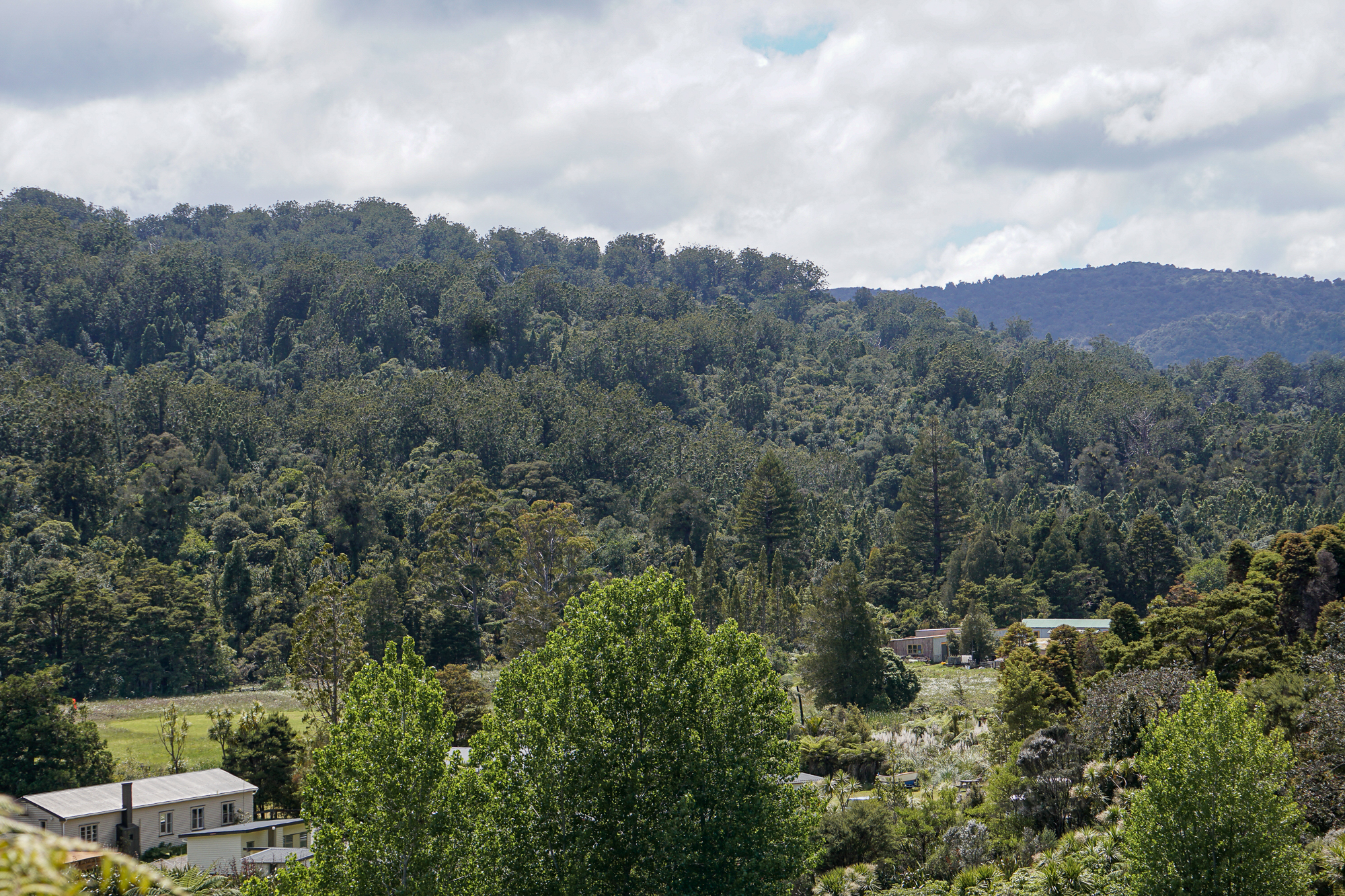
The offices of Te Roroa Group sit about 10km from the entrance to the Tāne Mahuta forest walk, adjacent to a public visitors center and an internally run visitor camping ground. They also sit about 20km from the Waipoua Settlement, a remote Māori community in which some of the Kauri Protection Ambassadors, kaumātua and employees of Te Roroa Group reside. Prior to the land settlement, the Waipoua Forest HQ building that houses Te Roroa Group housed the Crown’s management and research center for Waipoua. The settlement returned ownership and control to Te Roroa. Today, the Kauri Coast, Te Tai Kauri, DOC office nearest Waipoua is in Dargaville, about 45km south of the forest along the Kauri Coast via State Highway 12 (fig. 23).79 “DOC Offices.” Te Roroa Group, working with DOC, has persisted in and brought innovation to their stewardship of the Waipoua forest in face of this new threat. It is critical that the health of Waipoua, the mauri of kauri forests and the mana of Te Roroa are considered by all as totally linked.
Pest Control

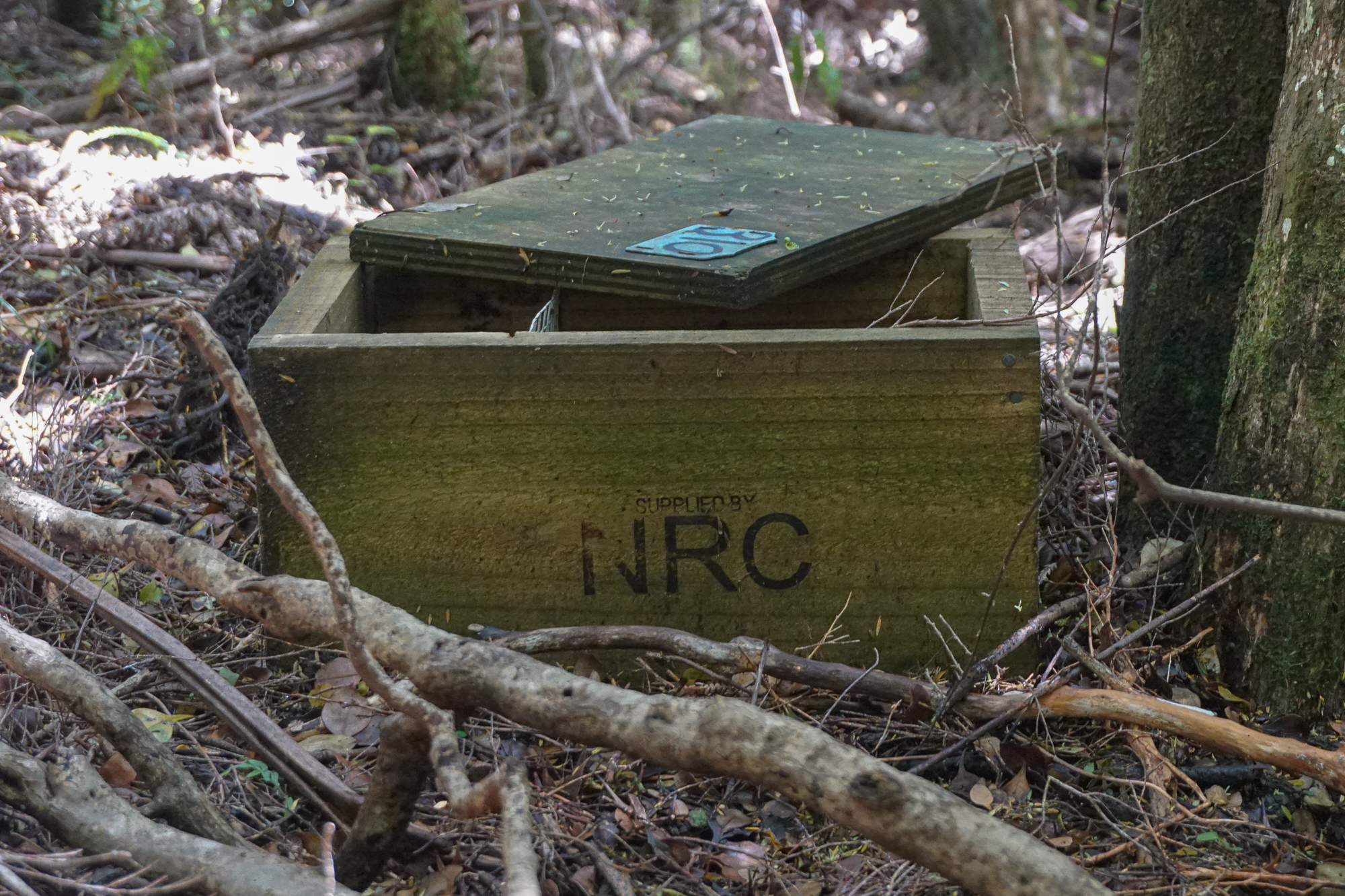
The Pest Problem
When European settlement introduced predatory mammals to New Zealand, the island once bursting with birdsong faced the scattering of possums, stoats, rats, cats, dogs, horses and pigs. For a time, these mammals served as hunting game and livestock for Māori and Europeans alike, but, without larger predatory mammals to limit numbers of mustelids and other pests, it did not take long for their numbers to grow considerably and surpass available natural population controls.
Even before P. agathidicida made landfall, these pests affected another of the nation’s precious taonga species. As introduced mammals competed with native birds for berries and fruit, they also irreparably decimated brown kiwi bird numbers through predation and habitat disruption. Leashing and “kiwi aversion training” for domestic dogs has suppressed kiwi fatalities in recent years, but the pressure these introduced mammals placed on native species is lasting. Kiwi recovery projects are underway but require active preservation through kiwi sanctuaries and stringent pest management in known kiwi protection areas.
1080 & Trapping Debate
The pest problem in Northland has seen a renaissance of scrutiny with the introduction of P. agathidicida. The same predatory mammals that harm kiwi exacerbate this new fungal threat to kauri so long as they inadvertently track soil from one forest to the next. The mustelids, wild horses and pigs roaming unbridled throughout the forests make containing Kauri Dieback Disease increasingly difficult for land stewards in Northland.
Māori have been enacting pest controls for as long as pests have tramped uninvited through their land but trapping is hard work and often results in unsatisfactory pest mitigation. I spoke to a volunteer trapper whose overall sentiment was that trapping, if not a full-time effort, is laborious and largely useless. She claimed that the best tool out there is 1080, and said that until a better option came along, that is what she would use. 1080 is the brand name given to the synthetic form of sodium fluoroacetate that is being used in New Zealand to control the invasive species populations of possums, rats, stoats and rabbits.80 “1080.” It is marketed as a biodegradable predator control toxin that dilutes and detoxifies easily in water. While the spray has incited public controversy, it has joined pest trapping as a primary control measure used by private land trusts and DOC to suppress pest populations and curb the spread of KDB.
The debate between pro-1080 and anti-1080 advocates is like a game of cat and mouse. Anti-1080 activists worry about residual chemicals leaching into the waterways and unintentionally exposing non-target animals, like dogs and livestock, to chemicals. Some also pose the question of whether or not 1080 affects the health-giving properties of plants so as to harm traditional rongoā practices. DOC is a public advocate for 1080 and claims that, when used according to regulations, it is a safe and effective way to control the predators that threaten native species. Because of public concern, DOC disseminates information from research done on 1080 on their website, most of which is aimed at shifting public opinion to alleviate fear.81 “1080.”
Once 1080 biodegrades in the soil, all that is left is natural compounds and minerals that include glycolate, fluoride and carbon at levels typically found in the environment. Further, testing on marine populations shows that the effect of 1080 on marine health is null.82 “1080, water and aquatic life”; 1080 and streams, rivers and lakes: Biodegradable 1080 for pest control.” Based on the stringent guidelines that the Ministry of Health has set for safety levels of residual 1080 in water, there is no evidence to suggest that the drinking water system has been contaminated based on the levels set up.83 “1080 and Tap Water.” Given the data, 1080 does not pose a viable threat to the health of natural systems in New Zealand though, as this project posits, Western data is only one measure of the health of the landscape and may not be the most comprehensive. The road signs scattered around Northland berating the propagators of 1080 signaled as much.
It does seem like the data is batting down some worries people have regarding the temporary use of 1080 to tamp down forest pests. More and more, people are realizing that some of their fears, like that of dogs eating bait, can be mitigated by changes in behavior, like leashing dogs, and that the real choice is whether or not to use the tools available to protect the ngahere. According to the volunteer trapper, “We have a choice, ngahere or no ngahere, simple. What do you want?”
Private Landowners & DOC
DOC has a budget for pest control measures that includes funding for trapping, workers’ wages, four-wheel drive vehicles and quad bikes, 1080 procedures, etc.. The resources are only allocated to be spent within the forest boundaries under DOC jurisdiction, so pest control procedures and monitoring stops at the boundary to privately owned land. Because of these parameters, no matter the diligence of employees, there are holes in DOC’s system. New pests are free to enter the forests daily from outside the pest-barrier and usually outpace DOC’s reactionary efforts to suppress their numbers. Every so often, private landowners convince DOC to heed their advice when it comes to pest management.
As the Environmental Coordinator for Te Rūnanga o Ngāti Hine, Kevin Prime formed the Kaitiakitanga o te Kuku restoration programme in conjunction with Landcare Research and the Department of Conservation for the protection and stewardship of the native wood pigeon. He first noticed the need to establish a pest control program because of the possums in Mōtatau State Forest, which borders his property. Since the infestation mostly came from outside the forest, he determined that extending the pest control buffer zone outside those borders may prevent possums from entering in the first place. Rather than approaching DOC to implement the buffer zone, he sought approval and involvement from the three other farms surrounding the forest to start a collective pest control program. Prime Holdings – the company set up for the business part of Kevin’s farm to manage the cattle, pine trees and charitable portion – put up the lion’s share of money and manpower, even helping out the farms that couldn’t afford to participate. Together, the landowners extended the buffer 1km outside of the forest and allowed them to successfully monitor seven bird nests against possum predation.
Kevin has been doing routine kiwi call counts on his property long before the day DOC caught wind of his elevated numbers and sent a ranger to his farm to determine if he was ‘cooking the books.’ Kiwi call counts allow landowners to monitor kiwi numbers in their area. Counts take place at night, in 30 minute intervals with two people stationed at different elevations to record the calls. Every time a kiwi bird screams, the counter shines their flashlight into the air. The light allows for the other person to see when a call is recorded so that calls are not counted twice.
The DOC ranger conducted a count with Kevin and together they recorded twenty nine calls, confirming Kevin’s records. When the ranger asked how his numbers were so high, Kevin explained that he identified the connection between mustelid and kiwi numbers two years prior, ordered 200 traps from England, and started pest controls right away. Once they reduced the mustelid numbers, the kiwi numbers quickly grew. It didn’t take long for DOC to notice and make Kevin’s property a high priority area for kiwi. They even offered to monitor the traps for him, which Kevin declined, noting the waste that would bring. Kevin and his guys could monitor the traps for a quarter of the price, and half the manpower of DOC. Here lies another difference between DOC and Māori reasoning: tikanga (protocol). Every approach to pest control exposes the negotiation between tikanga Pākehā and tikanga Māori that undergirds most practices in post-colonial New Zealand.
“When DOC has to come out they have to have two people [for safety reasons], they can’t double on the quads so they have to have two quads, and a four-wheel drive which means a trailer to bring the two quads. Then, they have to unload them etc.. Whereas I can have just one person, half the cost. It would take one of my guys about two hours. He’d be driving past there anyway, a trap is easy to tell if it has sprung if it’s daylight, if it’s not sprung you can see straight through it. So, he can drive straight past and see and make the observation. All you have to do is fund one of my workers for half a day which is a hell of a lot cheaper than the cost of the other option,” he explained, and added, “It took them a long time to get that message through but they did get the message about extending the buffers. It’s just about working with them.” He also added that he got on really well with the people ‘at the bottom’ so-to-speak, the DOC workers on the ground. “They did do a lot of things, like loaning us pre-feed. You don’t loan pre-feed because once the possums eat it, it’s gone. They were really good workers but often it was with the higher ups in the government level that it got tricky, but right at the bottom we had really good relationships and that’s what makes the difference – the relationships you’ve got with people on the ground,” said Kevin.
Influence of the Western Paradigm
Hygiene Stations, Track Upgrades & Behavioral Change
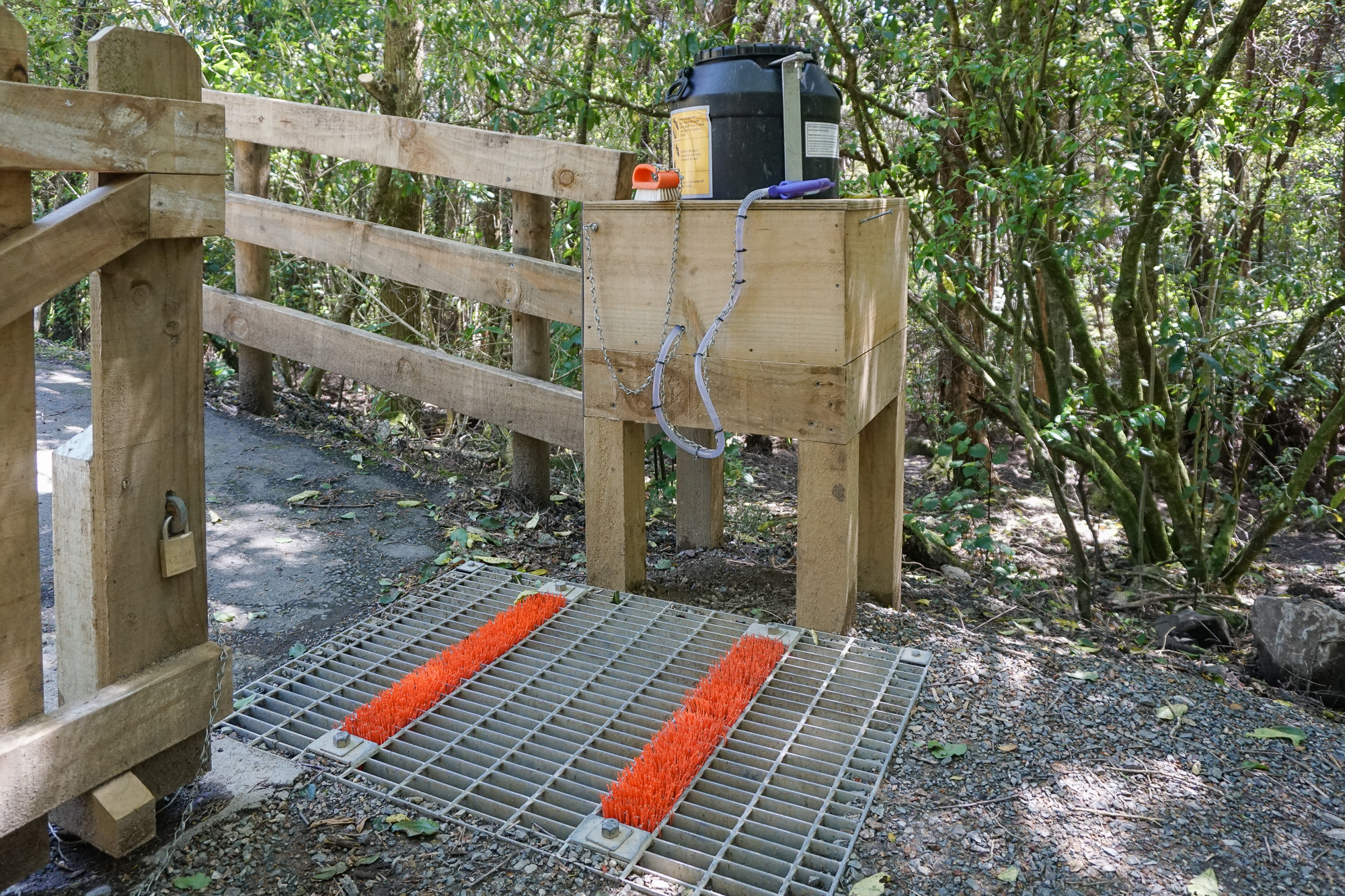
Hygiene stations, for cleaning soil from the boots and equipment of forest-goers, are a recent innovation that have become standard at the entrance of many Northland forests. Depending on regional funds, visitor traffic, the forest stewards’ relationship with DOC and general approach to Kauri Dieback Disease protection, the quality of station varies from barrel and grate to Mark II prototype cleaning stations. Forests with hygiene stations are usually designated by a controlled area notice implemented by the Ministry for Primary Industries under the Biosecurity Act.
Since P. agathidicida travels in dirt, the stations are designed to expel soil from the bottom of shoes, tires and miscellaneous equipment. The motto: Brush, Inspect, Disinfect. Each station is equipped with steel foot scrapers and hand-held water spouts and brushes to help visitors make a first pass at cleaning dirt from their footwear and the structure is fitted with rotating brushes that protrude from the metal flooring and treadles (push-operated dispensers) that spray a mist of Trigene Advance II (the diluted chemical substance used to exterminate P. agathidicida spores, now Sterigene) when stepped on. Visitors are expected to comply with the stations upon entry and exit of all kauri forests, so as not to track illicit soil in or out. According to behavioral change and cleaning station compliance studies conducted by DOC, 72% to 95% of track users showed partial to correct compliance.84 Joanne Aley and Edy MacDonald, “Kauri Dieback Recreation Project - Mark II Prototype Cleaning Station – Compliance Research Report.” The findings suggest that despite high overall deference of track users to hygiene stations, their behaviors still need to be shaped in order to improve correct compliance to instructions and safeguard the ngahere.

To broaden compliance, abundant Kauri Dieback signage icons, designed by both the Ministry for Primary Industries (MPI) and DOC, are posted at hygiene stations and along forest walks to communicate instructions regarding track usage protocol. A key part of the MPI’s Kauri Dieback Management Programme is to coordinate messaging and signage to be used by all stakeholders to educate track users and influence their behaviors, to stop the spread of the pathogen. After being tested in public settings to determine legibility of their messaging, the ‘inspect’ and ‘stay on track’ icons have been updated to reflect clearer iconography.85 Joanne Aley, “Kauri Dieback Recreation Project - Kauri Dieback Signage Icons: Public Testing.”
In addition to signage inside kauri protection areas, trails and forest walks are now upgraded to protect the forest floor. Elevated boardwalks have been built to ensure visitors remain on the track. Before these changes, visitors were free to walk right up to living kauri giants, causing irreparable damage to the fragile root system of kauri. Though the transition away from direct contact has mitigated the spread of Kauri Dieback, many mātauranga Māori practitioners begrudge the obstruction to their access to the bush. Despite their displeasure, compliance with hygiene stations, walkways and other controls in both the highly trafficked and less-frequented forest walks by both locals and tourists continues to grow, especially once paired with proper communication and education regarding Kauri Dieback.86 “Encouraging Action to Prevent the Spread of Kauri Dieback - Qualitative Report.”

Rāhui: A Dilemma of Scale
In certain circumstances, Māori have chosen to place a rāhui (prohibition or tapu restricting access to, or use of, an area or resource by its kaitiakitanga in order to protect it from harm or misuse) on natural areas. A recent catalyst for invoking rāhui in Northland has been Kauri Dieback Disease prevention but there are also rāhui on smaller areas, for example, on the intertidal rocks at Mitimiti beach to prevent young people from harvesting oysters in an area long-reserved for kaumātua.
In Ngātiwai, explained Hori Parata, “Our policy for wāhi tapu [sacred site] is this – all wāhi tapu are sacrosanct and cannot be entered for any other reason than for maintenance and study.” People generally accept that policy, but there are instances when the charge to protect an area is diluted in favor of public opinion. Parata argued that conservation is conflicted with consumption because the government relies on the public to vote them in. There is a balance between restricting access for the general public while allowing for the cultural relationship and maintenance within the forest to continue. For many, like the stewards of Warawara, that is what a rāhui brings. Still, the moment tourism developed as a permanent fixture in Northland’s economy, the consequences of barring access to certain areas involved both visitor withdrawal and resident resentment (recall the iwi who rejected hygiene station compliance). Plainly put, the stewards of popular natural areas face the dilemma of prioritizing forest health versus the economic vitality of their site.
While neither Māori nor Pākehā take the measure lightly, calling for a complete rāhui does occur (fig. 20). In fact, there are forests, both tourist magnets and lesser tramped, that have been completely shuttered to the public. The Waitakere Ranges Regional Park down by Auckland, a formerly magnificent kauri forest, victim of the logging industry, and modern tourist attraction that has been ravaged by Kauri Dieback, for example, has been closed, allowing only scientists and approved visitors within its boundaries. The decision to close the Waitakere Ranges came from the Auckland Council, Te Kaunihera o Tāmaki Makaurau, in February of 2018, after consultation with mana whenua Te Kawerau a Maki, Waitakere Ranges Local Board and local stakeholders and businesses.87 “Auckland Council Votes to Close Entire Waitakere Ranges Forests.” Another at-risk area, the main kauri grove at Auckland’s oldest and foremost public parks, Cornwall Park, has been cordoned off by means of a rope and electric fence to deter curious pedestrians and pests as part of an effort to restore the kauri grove restoration carried out by the Cornwall Park Trust and the School of Biological Sciences, University of Auckland.
The difference between the forests shuttered by iwi and by DOC is the pest management and research that takes place inside the closed forest. For example, Warawara is closed because of Kauri Dieback, yet there is still an active pest management program and ecological research that takes place in the bush because of the joint management and governance sorted between Te Rūnanga o Te Rarawa, DOC Kaitaia Office and the Northland Regional Council. Similarly, actions in Waipoua illustrate an implementation of rāhui that still considers the greater public access that DOC is often tasked with upholding. In some ways, it operates in a middle ground, with Te Roroa Group in control but DOC still present. Te Roroa has initiated a partial rāhui through track closures of infected areas as part of their strategy to protect kauri while maintaining their connection to the forest by preserving access to the cultural touchstones of Northland’s history. Under their partial rāhui, tracks to the Four Sisters and Yakas Kauri have been closed since 2018 (fig. 24).
Today, the only kauri walk tracks still open to public use are those to Tāne Mahuta and Te Matua Ngahere and both are closely monitored by Te Roroa Group Kauri Protection Ambassadors (KPA) to ensure visitors’ correct compliance with the hygiene station and boardwalk. The role of Kauri Protection Ambassadors reveals how track closures, hygiene stations, walkways and signage, though compelling, are ineffective unless foreign and local visitors understand the reason they exist to begin with. Educating visitors about P. agathidicida, and the cultural importance of the taonga that Kauri Dieback threatens to exterminate, is critical for the lasting protection of Northland’s kauri forests (more on Kauri Protection Ambassadors and Kauri Dieback education in chapter VIII).
New Zealanders have a small pool of options. Do they shutter all forested areas to public access until a cure for this disease is discovered, while shutting down the visitor economy that hinges on visiting those forests in the meantime? Do they selectively block access to confirmed infection clusters to prevent the disease from exiting red zones and entering healthy areas while still permitting visitors to use selected tracks, so long as they comply with hygiene stations and track signage? Do they invest in studies that assess how to change human behavior? Do they continue on with business-as-usual and welcome in the flood of visitors to the forests to run over the shallow root systems and hug the trees?
In the time since I left Northland, these options have become even more complicated as they expand to other realms of life in the face of yet another health crisis, this time a disease targeting humans rather than kauri...
Notes
- Forestry New Zealand, “One Billion Trees Programme,” Ministry for Primary Industries, last reviewed July 22, 2020.
- “Kauri Dieback - Phytophthora Agathidicida: The Problem,” The Kauri Project, accessed April 20, 2020.
- “Kauri Dieback - Phytophthora Agathidicida: The Problem,” The Kauri Project.
- Will Ngakuru, Michael Marsden, and Peter Nuttall, “Te Roroa Effects Assessment - Kauri Dieback Disease - (Phytophthora taxon Agathis - PTA)” (Te Roroa Group, June 2010)
- “Warawara Whenua Ngāhere i te Taiao,” Te Rūnanga o Te Rarawa, accessed April 20, 2020.
- “Warawara Whenua Ngāhere i te Taiao.” Te Rūnanga o Te Rarawa.
- “Warawara Whenua Ngāhere i te Taiao.” Te Rūnanga o Te Rarawa.
- “Te Rohe o Te Roroa,” Te Roroa, accessed February 20, 2020. See image, "Whenua Tūpuna."
- “Visiting Waipoua,” Te Roroa, accessed February 20, 2020.
- “Te Roroa Forests,” Te Roroa, accessed March 30, 2020.
- “Our Iwi,” Te Roroa, accessed May 15, 2020.
- “DOC Offices,” Department of Conservation/Te Papa Atawhai, accessed May 20, 2020.
- “1080,” Department of Conservation/Te Papa Atawhai, accessed March 10, 2020.
- “1080,” Department of Conservation/Te Papa Atawhai.
- “1080, water and aquatic life,” Department of Conservation/Te Papa Atawhai,
accessed March 10, 2020;
“1080 and streams, rivers and lakes: Biodegradable 1080 for pest control,” Department of Conservation/Te Papa Atawhai, accessed March 10, 2020. - “1080 and Tap Water,” Department of Conservation/Te Papa Atawhai, accessed March 10, 2020.
- Joanne Aley and Edy MacDonald, “Kauri Dieback Recreation Project - Mark II Prototype Cleaning Station – Compliance Research Report” (Department of Conservation/Te Papa Atawhai, October 2018).
- Joanne Aley, “Kauri Dieback Recreation Project - Kauri Dieback Signage Icons: Public Testing” (Department of Conservation/Te Papa Atawhai, October 2018).
- “Encouraging Action to Prevent the Spread of Kauri Dieback - Qualitative Report” (Kauri Dieback Programme, Colmar Brunton, March 2016).
- “Auckland Council Votes to Close Entire Waitakere Ranges Forests,” NZ Herald, February 19, 2018, sec. New Zealand.
